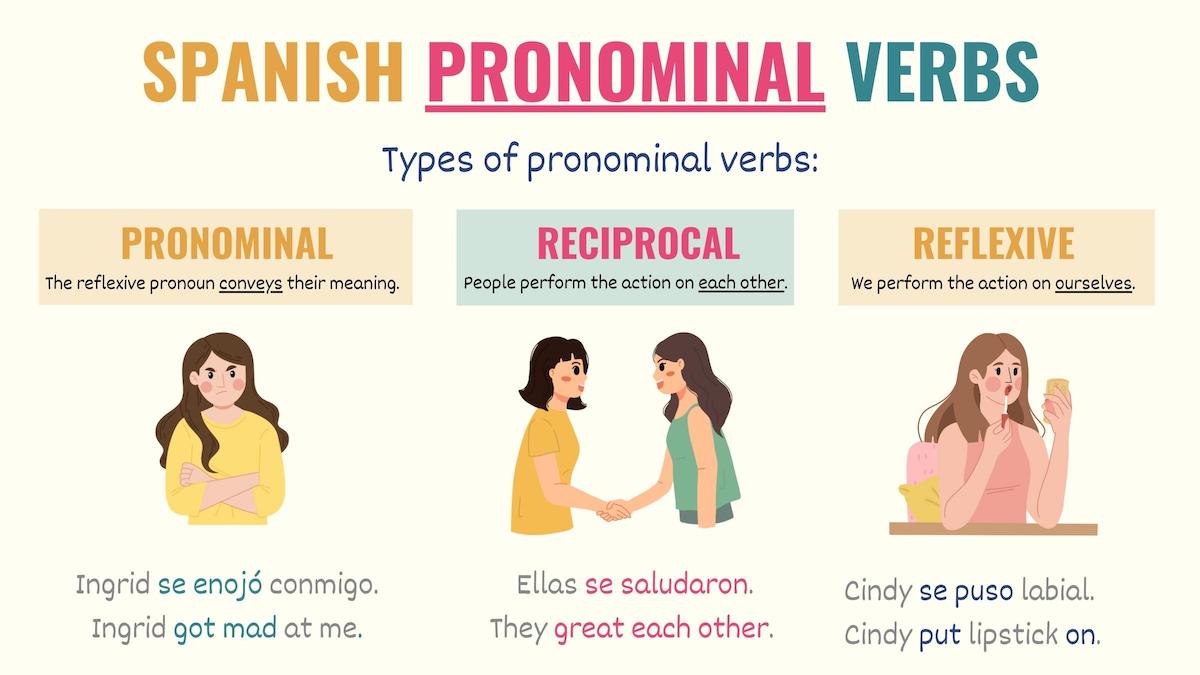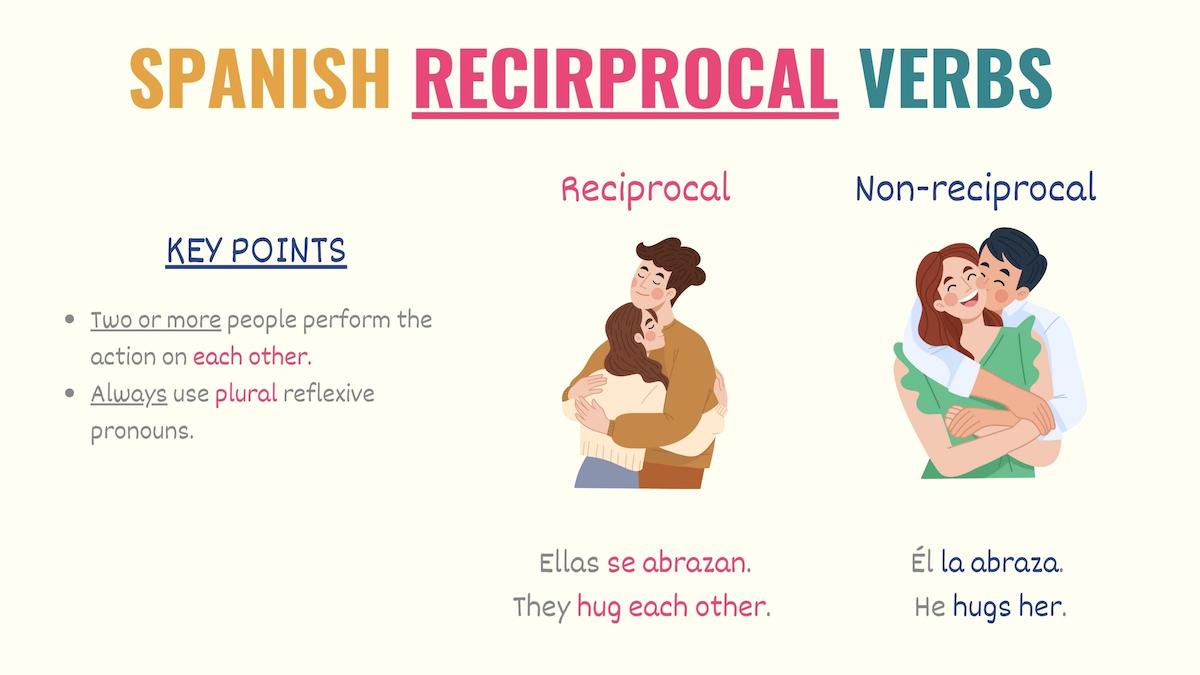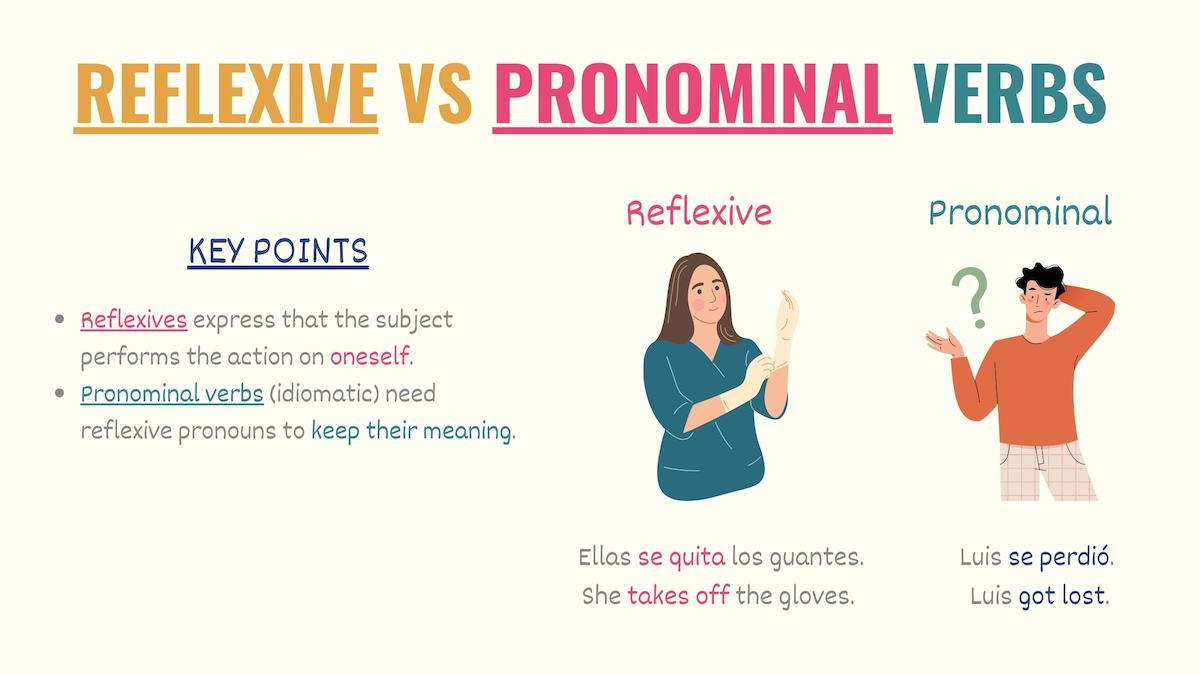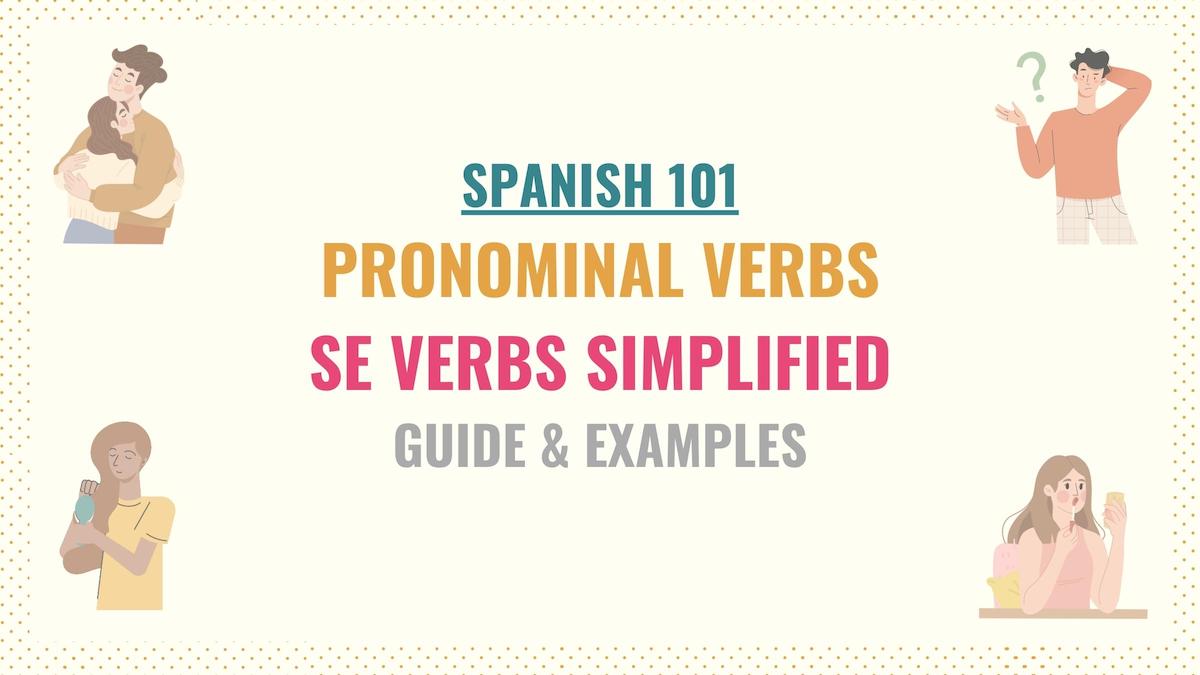When learning how to use and conjugate different types of verbs in Spanish, you’ll come across the term pronominal verb sooner or later. In short, Spanish pronominal verbs are an essential part of this language.
So, in this guide, we’ll go over the rules for using pronominal verbs. Here is an overview of what you’ll learn:
- SE Verbs Spanish Definition: How & When to Use them
- List of Pronominal, Reciprocal & Reflexive Verbs
- Key Points
- Additional Spanish Resources
- Downloadable PDF
You’ll find examples and graphics that help you understand when and how to use this type of verb in Spanish.
What Are Pronominal Verbs in Spanish
In Spanish, pronominal verbs are verbs that need a reflexive pronoun to convey their meaning. In infinitive form (not conjugated), pronominal verbs have a se ending. For instance:
- Bañarse
- Despedirse
- Ponerse
- Irse
In other words, in Spanish, you must use the appropriate reflexive pronoun when conjugating a verb that ends with a pronominal pronoun, like the ones listed above.

So, based on their meaning, these Spanish verbs are classified as reciprocal, reflexive, or idiomatic verbs (pronominal).
Take Note: Spanish reflexive pronouns are me, te, se, nos, and os. Remember that each subject has its reflexive pronoun. So, make sure you match them properly.
Reflexive verbs (expressing reflexive actions)
In Spanish, reflexive verbs are the most common type of pronominal. However, as its name suggests, a reflexive verb is only used to talk about reflexive actions. Simply put, this verb refers to an activity the subject performs on oneself.
Let’s check these sentences:
[Reflexive pronoun] + [verb conjugated]
Me cepillo los dientes.
I brush my teeth.
¿Tú te peinaste?
Did you do your hair?
Nosotros nos despertamos muy tarde.
We woke up very late.
As you can see in the translations above, unlike in Spanish, the reflexive pronoun doesn’t need to be included in the English sentence all the time.
Take Note: In Spanish, a reflexive verb is always considered pronominal. However, as you’re about to learn, this doesn’t mean that all pronominal verbs are reflexive.
Reciprocal verbs (expressing reciprocity)
The second type of pronominal verb is called reciprocal. Reciprocal verbs are used in Spanish to talk about the actions two people perform on each other. In other words, there is some reciprocity between these subjects.

Here you have some sentences:
[Reflexive pronoun] + [verb conjugated]
Ellos se besaron.
They kissed (each other).
Julia y yo nunca nos hemos caído bien.
Julia and I have never liked each other.
¿Cómo has estado? Hace mucho que no nos vemos.
How have you been? We haven’t seen each other in a long time.
Take Note: Because they both refer to actions received by the subject, reflexive and reciprocal verbs are often confused in Spanish. Make sure you understand the difference between them.
Idiomatic verbs (pronominal)
Finally, certain pronominal verbs must use reflexive pronouns in Spanish to maintain their meaning. Unlike reciprocal or reflexive, with these idiomatic verbs, the person doing the action is never the object.
Here are some examples of sentences using a pronominal:
[Reflexive pronoun] + [verb conjugated]
Yo nunca me quejo.
I never complain.
Ustedes se van muy temprano.
You guys leave very early.
¿Te divertiste en la fiesta?
Did you have a good time at the party?
Nos vamos en una hora, ¿ya estás listo?
We are leaving in an hour, are you ready?
Take Note: As a transitive verb, reflexives always need a direct object, which happens to be the same person doing the action. However, pronominals only use a reflexive pronoun to maintain their meaning. If they have a direct object, it will never be the same as the sentence’s subject.

Spanish Vocabulary: List of Common Pronominal Verbs
Now that you understand how each verb works, here is a list of Spanish pronominal verbs you should include to your vocabulary:
Reflexive verbs:
- Afeitarse: To shave
- Acostarse: To lie down
- Bañarse: To bathe / To shower
- Cepillarse: To brush
- Despertarse: To wake up
- Lavarse: To wash oneself
- Ponerse: To put on
- Quitarse: To take off
- Vestirse: To get dressed
A good tip to remember is that reflexive verbs are mostly used to talk about daily routines in Spanish.
Reciprocal:
- Amarse: To love each other
- Caerse bien: To like each other (friends)
- Despedirse: To say goodbye to each other
- Gustarse: To like each other (romantically)
- Perdonarse: To forgive each other
- Saludarse: To say hi to (or greet) each other
Pronominal:
- Alegrarse: To be happy
- Comerse: To eat all of something
- Dirigirse: To head for / To address
- Divertirse: To have fun / To have a good time
- Enojarse: To get mad
- Irse: To leave
- Llamarse: To be named
- Meterse: To meddle / Mind your own business
- Morirse: To die
- Negarse: To refuse
- Perderse: To get lost
- Preocuparse: To worry
- Sentirse: To feel
- Quedarse: To stay
- Quejarse: To complain
- Volverse: To become
Take Note: In Spanish, removing the reflexive pronoun from pronominal verbs (idiomatic type) can cause a change in meaning. For example, quedar means ‘to fit’ or ‘be left’, whereas quedarse means ‘to stay’.
Key Points
Spanish verbs are an important part of speech. And pronominals are an important type of verb. Here are some essential points you need to know:
- In Spanish, pronominals must include a reflexive pronoun in their conjugation.
- People often call them se verbs because their infinitive form ends with the pronoun se.
- Based on their meaning and elements, these verbs are classified into:
- Reflexive verbs: actions where the subject and object are the same.
- Reciprocal verbs: two or more subjects which act on each other (reciprocity).
- Pronominal (idiomatic) verbs: use reflexive pronouns to keep a specific meaning.
- In Spanish, when conjugating these verbs you must use a reflexive object pronoun.
- In some cases, non-reflexive verbs may have different meanings than pronominals.
Pronominal Verb-Related Resources
If you’re serious about learning Spanish, here are some useful links you should check out to understand these types of verbs. First, get familiar with reflexive verbs and their subject pronouns so you can understand how to pair them correctly. Second, make sure you know how to conjugate reflexive verbs and where to place these pronouns correctly.
Be aware that, in Spanish, the pronoun ‘se’ is a powerful word with multiple applications. Learning its different applications can help you avoid any confusions.
Also, getting familiar with Spanish direct object pronouns can help you understand how a reflexive verb works. If the action is not reflexive (meaning you’re directing to someone else), you’ll need to use a direct object pronoun.
Finally, learning how to conjugate pronominal verbs is challenging for most students. Here are reflexive verbs you can use as guidelines. One of these verbs has a regular conjugation, while the others include some stem changes.
- Spanish Levantarse Conjugation Guide
- How to Conjugate Vestirse in Spanish
- Despertarse Conjugation Guide in Spanish
Download the Pronominal Verb Cheat Sheets PDF
Learning how to use – let alone tell apart – a reflexive, reciprocal and idiomatic verb can be daunting. However, Spanish pronominal verbs are critical to your conversational success and fluency. I’ve compiled a PDF you can download containing the key points, differences, charts and examples from this guide so you can study at your own pace.



